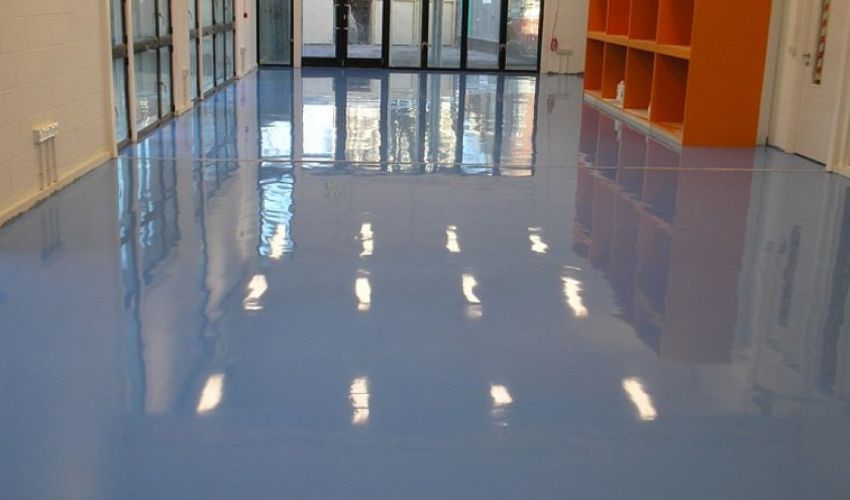Epoxy floor is an excellent option for many homeowners because it’s durable, low-maintenance, and can be customized to suit any room in your home. But with so many great benefits come a few drawbacks that you should know about before you make your decision.
Coatings and flooring are crucial for the safety of your home, and they protect the floors from damage and make them easier to clean.
Epoxy flooring is a type of flooring that is not only durable but appealing to the eye. However, this type of floor has flaws that are usually unknown to many people. In this article, we will discuss some disadvantages of epoxy flooring and give you an honest review if it’s right for you.
Why Is Epoxy Flooring so Popular?

There are many reasons epoxy flooring is so popular. Epoxy floor service is also popular because it is much more affordable than other types of flooring. It can be installed quickly and easily and does not require special skills or training.
Epoxy floor is also environmentally friendly, not off-gas, and is made from recycled materials.
What Are the Disadvantages of Epoxy Flooring?
Epoxy floor is pricey, which is one of its disadvantages. Depending on brand and quality, epoxy might cost twice as much as concrete. Epoxy floor may be slippery when wet, which can be dangerous in high-traffic or damp areas. Damaged epoxy flooring is tough to repair.
Installation

The problematic installation technique is unquestionably a drawback of epoxy floor. Before applying an epoxy coating, the surface must be appropriately prepared. All oils and grease must be removed before refinishing a garage floor, which can be challenging.
When installing epoxy floor, every detail is crucial, and you must follow all the rules precisely. You will need to pay attention to factors such as the self level flooring, as excessive moisture can cause the floor to deteriorate and age prematurely.
In addition, health precautions must be taken during installation, mainly if a non-water-based product is used. The fumes can irritate your eyes and respiratory system. However, it should be noted that once epoxy floor has fully cured, it is safe and poses no health risk unless the surface must be sanded.
Temporary
Epoxy is a temporary flooring solution and one of the significant drawbacks of using it on your floors. Although durable and resistant, you will eventually need to replace it. Unlike other flooring options, epoxy floors are susceptible to everyday wear and tear. To maintain the appearance, you must apply a fresh coat of epoxy. This is inevitable when heavy objects are dropped on the floor’s surface.
Preparation

Preparing existing floors for the application of epoxy is laborious, and a considerable amount of effort is also expended. Before applying the epoxy coating, the concrete floor must be clean and devoid of grease, oil, and solvents.
Additionally, cracks will need to be filled. Cleaning concrete floors requires multiple attempts, and this necessary preparation work is a disadvantage. The good news is that homeowners will find it relatively simple and quick to apply with hand tools due to advancements in manufacturing and application techniques.
Requires Repairs
Despite its extreme durability, epoxy floor is not a permanent solution, so periodic reapplication is required. Even though epoxy is highly durable, the surface will still be subject to wear and tear and can even chip and crack. A chip or crack could cause the epoxy surface to peel and expose larger sections of the floor if left unattended.
Removal

Once installed, epoxy flooring can be challenging to remove. Typically, it is best to hire a contractor to do the job, as they will have the necessary equipment and knowledge to remove the surface safely while protecting the concrete base.
Smell
Wet epoxy emits potent fumes. Epoxy with darker hues contains more hardeners than lighter hues. They have an ammonia-like odor after application.
Sensitivity

Epoxy floor must be installed precisely per the instructions. If you do this, the flooring will only endure briefly. The coating is also quite easily scratched, making it very difficult to remove paint overspray.
The coating should only be applied during the season with the lowest relative humidity, and this is because moisture can diminish the durability of these floors.
Before applying your first coat of resin, we recommend using a dehumidifier for 24 hours to reduce the humidity. This will extract as much moisture as possible from the air, preventing water from becoming trapped under the floor after the resin finish has been applied.
Adherence
Before applying epoxy, the concrete floor must be thoroughly dried, prepared, and cleaned to avoid adhesion issues. Epoxy adhesion is poor in damp environments, such as a basement, and it will peel if the epoxy paint is applied to a wet floor in a humid climate.
Epoxy Fades with Age

The fading of Epoxy floor over time is a significant concern and disadvantage for many homeowners. This is because UV radiation from the sun can cause the epoxy to become discolored and degrade.
While this can not be an obstacle for some, it can be an eyesore for others. To prevent this from occurring, it is essential to safeguard your flooring. If your base coat is epoxy, you can also color your polyurethane. This will assist in preventing any ambering or yellowing from developing.
Substitutions for Epoxy Flooring
If you are looking for something different but competitive to epoxy, you have many options, including:
- Paint For Concrete: Painting your concrete floor is an alternative to epoxy, and this can give you a similar appearance to epoxy without the slick surface.
- Porcelain Tile: If you’re searching for a durable and easy-to-clean material, porcelain tile is an excellent alternative. It is also slip-resistant, making it an ideal choice for locations where barefoot walking is ordinary.
- Interlocking Plastic or Rubber Tiles: Another option to epoxy is interlocking plastic or rubber tiles. These can be trimmed to suit any location and are simple to install.
- Polyurea Polyaspartic: This is a relatively new form of flooring that resembles epoxy but has additional advantages. It is more robust and resistant to fading, making it an excellent option for locations exposed to intense sunshine.
- Coating Urethane-Acrylic or Polyurethane Topcoats: These are less hazardous than epoxy and have a similar appearance. Additionally, it is more flexible and less prone to break at high temperatures.
Conclusion
If you’re searching for a flooring material that is sturdy and long-lasting, epoxy can be the way to go. Before selecting, you should be informed of the downsides of epoxy floor.
You’re welcome. This article explained epoxy flooring’s drawbacks. Write down what you want from your flooring and where it will be used if you’re still deciding. Then, compare the flooring options you’re considering.







